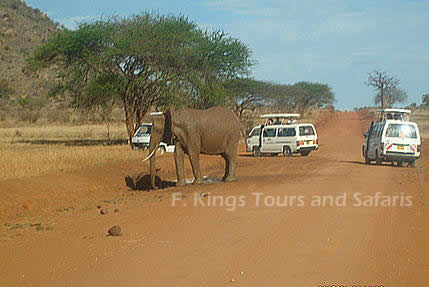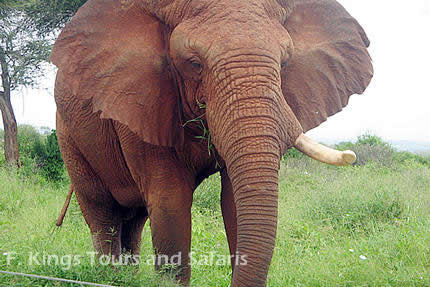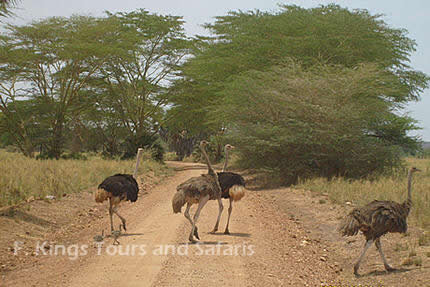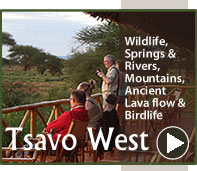|
Mudanda Rock (located near Voi and Manyaki
gates) is one of the great spectacle of
the park. This massive rock, which
emerges from the plain, is 1.6 km long,
20 m high and 100 m wide.
The Yatta Plateau is impressive lava flow,
one of the largest and longest of the world
(300 km long and 10 km wide) and lies along
the Athi river.
Wildlife in Tsavo National Park
: Despite the large size of the park,
there is a great concentration of
wildlife. The park is internationally
known for its large herds of red-dusty
elephants
Mzima springs is an oasis at the heart
of Tsavo West National Park. The pure water
of the three Mzima's pools filtered by the
porous sponge-like rocks of the Chyulu
Hills.
Climbing the Roaring Rocks
will give you magnificent panoramic
views over the Rhino valley and the
Ngulia Hills.
Rhino Sanctuary
At the base of the Ngulia Hills, is a
fenced area established to protect and
conserve the rare black rhinoceros and
is now a sanctuary to more than 50
rhinoceros.
Poacher's
Look out; a fine observation point of
Tsavo West with panoramic views of the
park. The look out faces Mount
Kilimanjaro and the best time to go
there is early in the morning.
The Man-Eaters of Tsavo:
In 1895, the construction of railway
going from Mombasa to Kampala (Uganda)
began. It took 8 years to complete the
work. In the summer of 1898, the
construction of the railway suddenly
stopped at the Tsavo river area because
of man-eating lions attacks. It is
believed that at least 100 peoples were
victims of the devil lions.
Mount Kilimanjaro:
all
said and done, Mount Kilimanjaro is best
viewed from Amboseli. Opportunities to photograph Elephants as they stride in front of
the mountain invite every tourist
Wildlife:
Amboseli National Park is one of the
best places to see elephants in Kenya.
In addition to the elephants, you are
sure to see the zebra, gnu,
hippopotamus, buffalo, spotted hyena,
waterbuck, Masai giraffe, Thomson's and
Grant's gazelle, impala, lion and
cheetah.
Lake Amboseli: is
a
flat and dry area which was 10'000 years ago a large and
permanent lake of 40 meters deep. Today it is a small seasonal lake
existing only after heavy and prolonged rains. Most
of the dry-lake bed is covered by alkaline white
ashes, remains of the eruption of the Kilimanjaro a few
thousands of years ago. when dry, you can drive on
the lake bed, when it it is full hippo
inhabit it and elephants and buffaloes and
other game visit it to quench their thirst
and wallow |
























